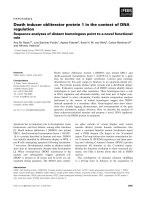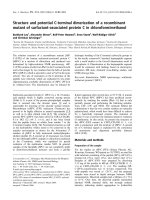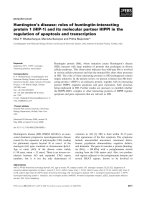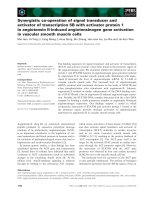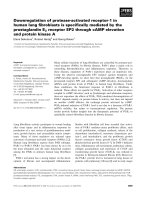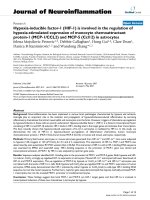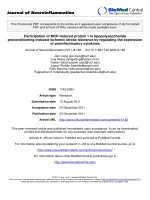ROLES OF HUNTINGTIN ASSOCIATED PROTEIN 1 IN INSULIN SECRETING CELLS
Bạn đang xem bản rút gọn của tài liệu. Xem và tải ngay bản đầy đủ của tài liệu tại đây (1.07 MB, 97 trang )
ROLES OF HUNTINGTIN ASSOCIATED PROTEIN-1 IN
INSULIN-SECRETING CELLS
XIE BING
NATIONAL UNIVERSITY OF SINGAPORE
2011
ROLES OF HUNTINGTIN ASSOCIATED PROTEIN-1 IN
INSULIN-SECRETING CELLS
XIE BING
(B.Sc., SICHUAN UNIVERSITY)
A THESIS SUBMITTED
FOR THE DEGREE OF MASTER OF SCIENCE
DEPARTMENT OF BIOCHEMISTRY
NATIONAL UNIVERSITY OF SINGAPORE
2011
Acknowledgements
I should like to thank my supervisor A/P Li guodong for his guide and
support during these years. Without his constructive criticism and endless
patience, I cannot complete this project.
Many thanks to all the staffs in our lab. The friendly atmosphere facilitated
my study. With their help, I can successfully carry out this project.
Finally, I would like to thank the National University of Singapore to provide
me the research scholarship and offer me a precious opportunity to study
here.
i
Table of Contents
Acknowledgements
ⅰ
Table of Contents
ⅱ
Summary
ⅴ
List of Tables
ⅶ
List of Figures
ⅷ
List of Abbreviations
ⅸ
CHAPTER 1 INTRODUCTION
1
1.1 β-cell and insulin secretion
2
1.1.1 Diabetes mellitus
2
1.1.2 Insulin
3
1.1.3 Insulin secretion
4
1.1.4 insulin-secreting cell model
8
1.1.5 β-cell growth and cell cycle
8
1.2 HAP1
10
1.2.1 HAP1 background
10
1.2.2 HAP1 function
12
1.2.3 HAP1 distribution in the β-cells of pancreatic islets
15
1.3 Aims and significance of this study
16
ii
CHAPTER 2 MATERIALS AND METHODS
19
2.1 Materials
20
2.2 Methods
23
2.2.1 INS-1 cell culture and storage
23
2.2.2 RNA extraction
24
2.2.3 cDNA preparation and SYBR green based real-time PCR
25
2.2.4 Transfection
28
2.2.5 Measurement of DNA content
30
2.2.6 Western blotting
31
2.2.7 Assessment of insulin secretion
35
2.2.8 Assessment of glucose metabolism by MTS test
37
2.2.9 Measurement of membrane potential
38
2.2.10 Measurement of intracellular Ca2+ concentration
39
2.2.11 Investigation of cell growth and death
40
2.2.12 Caspase-3 activity assay
41
2.2.13 Statistical analysis
43
CHAPER 3 RESULTS
44
3.1 The role of HAP1 in insulin secretion
45
3.1.1 Transfection of siRNA Knocks down HAP1 in INS-1 cells
45
3.1.2 HAP1 knockdown inhibits stimulated Insulin secretion
48
3.1.3 Knockdown of HAP1 does not affect glucose metabolism
53
3.1.4 Knockdown of HAP1 does not alter membrane potential
54
3.1.5 Knockdown of HAP1 does not change [Ca2+]i
57
3.2 The role of HAP1 in cell cycle
59
3.2.1 Knockdown of HAP1 affects INS-1 cell growth
59
3.2.2 Knockdown of HAP1 causes changes in the cell cycle
61
3.2.3 Knockdown of HAP1 does not activate caspase-3
63
iii
CHAPTER 4 DISCUSSION
65
4.1 Roles of HAP1 in insulin secretion pathway
68
4.2 Roles of HAP1 in the cell cycle
72
4.3 Conclusion
74
4.4 Future works
74
Bibliography
77
iv
Summary
Huntingtin associated protein-1 (HAP1) is a novel protein found in the
patient of Huntington’s disease. Some reports show that it might act as a
scaffold in the assembly of protein complexes and participate in
intracellular trafficking. Furthermore, there is evidence that HAP1 is
expressed in pancreatic islet β-cells.
In my project, I knocked down the HAP1 expression by RNAi technique in
INS-1 cells (a insulin secreting cell line from rat insulinoma). In insulin
secretion experiment, the knockdown cells secreted less insulin upon the
stimulation by high concentrations of glucose compared with the control
cells treated with scramble siRNA. In addition, high KCl-induced insulin
secretion was also inhibited. However, my results indicated that HAP1
knockdown did not affect glucose metabolism and, glucose-induced
membrane potential depolarization and intracellular Ca2+ elevation. On the
other hand, HAP1 knockdown reduced INS-1 cell growth and affected cell
cycle by arresting them at G2/M phase. However, apoptosis was not
induced by HAP1 knockdown in INS-1 cells.
Thus, it can be concluded that HAP1 knockdown not only reduced glucosestimulated insulin section by interfering with the step beyond [Ca2+]i rise in
the secretion process cascade, but also slowed down the growth of INS-1
v
cells without induction of apparent apoptosis. These data suggest that
HAP1 may participate in the regulation of insulin secretion and growth of
pancreatic islet β-cells.
vi
List of tables
Table 1. Materials and their involving experiments
20
Table 2. The components for RT-PCR (one reaction)
26
Table 3. The components for SYBR green real-time PCR (one reaction)
27
Table 4. Parameters of performing SYBR green real-time PCR
27
Table 5. Primers for SYBR green real-time PCR
28
Table 6. Sequences of siRNA duplex targeting rat HAP1 mRNA
29
Table 7. Some conditions in Western Blotting
34
vii
List of Figures
Figure 1. The classic signaling pathway for insulin secretion from β-cells
6
Figure 2. Knockdown of HAP1 in INS-1 cells
48
Figure 3. Effects of HAP1 knockdown in INS-1 cell on insulin secretion
induced by glucose and other secretagogues
52
Figure 4. HAP1 knockdown did not change glucose metabolism
54
Figure 5. HAP1 knockdown at 72h did not alter membrane potential in
INS-1 cells
56
Figure 6. HAP1 knockdown did not affect intracellular free Ca2+
concentration
59
Figure 7. HAP1 Knockdown decreased INS-1 cell growth
61
Figure 8. HAP1 knockdown did not induce apoptosis but changed cell
cycle in INS-1 cells
63
Figure 9. HAP1 knockdown in INS-1 cell did not activate caspase-3
64
viii
ABBREVIATIONS
All abbreviations definitions show at their first appearance in the text and
some frequently used abbreviations are also listed as following:
Ac-CoA
acetyl-coenzyme A
AMP
adenosine 3’ –monophosphate
ATP
adenosine 5’ –triphosphate
BSA
bovine serum albumin
[Ca2+]i
cytoplasmic free Ca2+ concentration
cAMP
adenosine 3’, 5’ –cyclic monophosphate, cyclic AMP
Caspase
Cysteine-requiring Aspartate protease
DAG
diacylglycerol
DEPC
diethyl pyrocarbonate
DMSO
dimethyl sulphoxide
DPBS
Dulbecco’s phosphate buffered saline
DNA
deoxyribonucleotide acid
DTT
dithiothreitol
EDTA
ethylenediaminetetraacetic acid
EGTA
ethylene glycol-bis(beta-aminoethyl ether)-N,N,N’,N’teraacetic acid
FACS
fluorescence-activated cell sorting
FITC
fluorescein-5-isothiocyanate
GLP
glucagons-like peptide
ix
Glut2
glucose transporter-2
GSIS
glucose stimulated insulin secretion
GTP
guanosine triphosphate
HEPES
N-[2-hydroxyethyl] piperazine-N’-[2-ethanesulfonic acid]
HRP
horseradish peroxidase
IBMX
3-isobutyl-1-methylxanthine
kDa
kilo-Dalton
MTS
3-(4,5-dimethylthiazol-2-yl)-5-(3carboxymethoxyphenyl)-2-(4-sulfophenyl)-2Htetrazolium
NADPH
nicotinamide adenine dinucleotide phosphate
PA
phosphatidic acid
PAGE
polyacrylamide gel electrophoresis
PBS
phosphate-buffered saline
PI
phosphatidylinositol
PKA
cAMP dependent protein kinase
PMS
phenazine methosulfate
PMSF
phenylmethylsulfonyl fluoride
PVDF
polyvinylidene difluoride
RER
rough endoplasmic reticulum
RISC
RNA induced silencing complex
RNA
ribonucleotide acid
RNAi
RNA interference
RRP
ready releasable pool
x
SDS
sodium dodecyl sulphate
shRNA
short hairpin RNA
siRNA
short interference RNA
SNARE
soluble N-ethylmaleimide-sensitive factor attachment
protein receptor
TBS
tris-buffered saline
TBS-T
TBS with 0.5% Tween-20
T1DM
Type 1 diabetes mellitus
T2DM
Type 2 diabetes mellitus
TEMED
N,N,N’,N’-tetra methylthylene diamine
VAMP
vesicle-attached membrane protein
xi
CHAPTER 1
INTRODUCTION
1
1. Introduction
1.1 β-cell and insulin secretion
1.1.1 Diabetes mellitus
Diabetes mellitus is a metabolic syndrome which causes systemic
microvascular diseases, especially in heart, eye and kidney. Diabetes
mellitus is the third most critically chronic disease after cardiovascular
disease and cancer. It was estimated by World Health Organization (WHO)
that there was 220 million diabetes patients worldwide in 2009 [1, 2].
Diabetic patients show a chronic hyperglycemia and insulin deficiency. So
far, two main types of diabetes mellitus are classified [3]: Type 1 diabetes
and Type 2 diabetes. Patients with type 1 diabetes cannot produce insulin
by themselves, thus have to inject insulin substitute to maintain glucose
homeostasis. On the other hand, type 2 patients result from relative insulin
deficiency and insulin resistance, in which cases, cells cannot properly use
insulin [3].
Pancreatic β-cells, which produce and secrete insulin, play a key role in the
development of diabetes mellitus. Although two types of diabetes have
different onset mechanisms, the common part in their pathology is the
insulin secretion dysfunction. In type 1 diabetes, T-lymphocyte-mediated
2
autoimmune attack and destroys β-cells, which fail to release insulin. In
contrast, insulin resistance is the main factor for the development of type 2
diabetes. Besides, insulin deficiency is also considered as a key etiological
cause. Absolute insulin deficiency means that β-cells are destroyed by
hyperglycemia [4-6], and the total number of β-cells is decreased; however,
relative insulin deficiency refers to the fact that insulin fails to take action
properly in the cells and the insulin receptors cannot correctly carry on the
subsequent signaling cascade triggered by insulin. As a result, two types of
diabetes involve abnormal insulin secretion [7-9]
1.1.2 Insulin
Insulin is a 51 amino acid hormone produced and secreted by the β-cells in
the Islets of Langerhans in pancreas [10]. Insulin consists of two chains (A
and B) linked together by disulfide bonds. In the secretory granules of βcells, insulin is stored in the inactive and stable hexamer form, while the
active form is the monomer form [11]. The amino acid sequence of insulin
is greatly conserved among animals. Insulin from other mammals thus is
biologically active in human beings. This is the applicable basis to facilitate
insulin extracted from other species, such as porcine insulin, to treat
diabetic patients in the early days [12]. Insulin regulates a series of other
cellular activities, such as protein and fat synthesis, RNA and DNA
synthesis, as well as cell growth and differentiation. One of its main
3
functions is the promotion of glucose uptake from the systemic circulation
into target tissues such as liver, muscles and adipose [13].
Glucose and other nutrients can enhance insulin expression in transcription
and translation level. Insulin gene transcription is regulated by many
transcription factors, such as, Pdx1, NeuroD, MafA and so on [14, 15]. The
product of insulin gene transcription is preproinsulin mRNA. The
preproinsulin carries a signal peptide, which facilitates preproinsulin to
enter rough endoplasmic reticulum (RER) lumen. Consequently, the signal
peptide is hydrolyzed and the proinsulin is properly folded . After this,
proinsulin is transported to the Golgi apparatus where the disulfide bonds
between A chain and B chain are formed after a connection peptide in the
middle region is removed by prohome convertases. The mature insulin and
equimolar C-peptide is enveloped in secretory granules ready for secretion
upon stimulation of β-cells [16, 17].
1.1.3 Insulin secretion
The insulin secretion response to the elevation of extracellular glucose
concentrations is a sigmoid relationship. There is no apparent influence on
insulin secretion if glucose concentration is below about 3 mM. With the
increase of glucose from 4 to 17 mM, the physiological range [18, 19], the
4
largest insulin secretion occurs. However, the insulin secretion seems to
attain a plateau even with higher glucose stimulation [20].
A biphasic insulin secretion pattern is observed in pancreatic β-cells upon
the stimulation by an increase of glucose concentrations [21, 22]. In
isolated rat islets, a rapid and transient increase of insulin secretion (first
phase) arise briefly 1 to 2 min later after the stimulation. The increase of
secretion rate reaches a peak 2 min later, and declines to the bottom at
time point of 8 min. After this, a slow but sustained secretion (second
phase) reaches a plateau after about 36 min [23].
A complex network of signaling pathways is involved in the glucosestimulated biphasic insulin secretion [23-25]. With the assistance of
glucose transporter-2 (Glut2), glucose diffuses into β-cells and is
phosphorylated by glucokinase, followed by metabolism through glycolysis
and mitochondrial oxidation via the citric acid cycle. This leads to the
increase of cellular ATP/ADP ratio, resulting in the close of ATP-sensitive
K+ (KATP) channels and depolarization of membrane potential of cells.
Consequently, the voltage-dependent Ca2+ channels are opened and a rise
of intracellular free Ca2+ levels ([Ca2+]i) ensues, which triggers insulin
release via exocytosis of granule fusion with the plasma membrane. On the
other hand, the KATP channel-independent pathways potentiate the Ca2+mediated secretory process [26]. Furthermore, there is evidence
5
supporting that the KATP channel-independent pathway of glucose
metabolism is responsible for the second phase of glucose-stimulated
insulin secretion. However, the underlying mechanism remains to be
elucidated.
Figure 1. The classic signaling pathway for insulin secretion from β-cells
Insulin-containing granules are located in two different pools [27]: docked
pool and reserve pool. The granules in the reserve pool are larger than the
docked granules. The granules in the docked pool convert between several
states for the rapid first phase release. They may be in the primed, readily
releasable and immediately releasable status. Upon the stimulus of [Ca2+],
exocytosis occurs. Once the docked granules are discharged, the granules
6
in the reserve pool are activated and translocated to the docked pool for
the sustained second phase release.
There are many other physiological and pharmacological regulators for
insulin secretion besides glucose [28]. Generally, they are classified into
three categories: initiators, potentiators and inhibitors. The initiators can
initiate insulin secretion on their own. Some fatty acids and amino acids
may act in this way. Sulphonylureas, such as tolbutamide and
glibenclamide, are potent KATP-channel blocker and thus are used for
clinical treatment of type 2 diabetes [29, 30]. The potentiators cannot
trigger the insulin release, but they are able to strengthen the already
activated secretion process. Forskolin, for instance, is usually used to raise
levels of cyclic AMP (cAMP) which activates protein kinase A (PKA) [31].
The latter can potentiate the insulin secretion. Glucagon and glucagon-like
peptide 1 increase glucose-stimulated insulin secretion also in this manner
[32]. Conversely, the inhibitors block the process of insulin secretion. They
affect the K+ and Ca2+ channels or prevent the exocytosis of insulin
granules. For example, diazoxide is an ATP-sensitive K+ channel activator,
which can be used to inhibit insulin secretion in insulinoma patient [33].
And, some neurotransmitters and hormones belong to this group, such as
adrenalin and somatostatin.
7
1.1.4 insulin-secreting cell model
The availability of great amount and stable insulin-secreting cells is
essential for the research in diabetes and β-cell biology. The isolation of a
considerable number of β-cells from pancreatic islets is time-consuming
and laborious. Additionally, the β-cells from islets cannot maintain a stable
culture for a long period. And their ability to synthesize insulin rapidly
declines in vitro. Therefore, dozens of insulin-secreting cell lines have been
created by induced insulinomas, viral transformation, and transgenic mice
[34]. Among them, the INS-1 cell line from rat insulinoma is a most widelyused cell line [35]. INS-1 cells display many aspects of primary β-cells
including morphological characteristics typical of native β-cells, high insulin
content, response to glucose stimulation, Ca2+ mediated exocytosis and so
on. Thus, INS-1 cells are widely used as a paradigm to study diabetes and
insulin secretion.
1.1.5 β-cell growth and cell cycle
It is generally accepted that β-cell mass is dynamic and oscillates both in
function and mass to sustain the glucose level within a restricted
physiological range [36]. The changes involve with individual cell volume,
cell replication and neogenesis, and cell death rate [37]. Mature β-cells
have very weak ability to proliferate and are readily replaced when
8
destroyed. An increase of β-cell growth may occur in certain
circumstances, e.g. after new born, pancreatectomy, or in pregnancy.
In T2DM patients, data shows that there is compensatory growth of β-cell
mass at the early stage due to the insulin dysfunction and insulin
resistance [38]. There are two ways to maintain the normal glucose level: to
produce and secrete more insulin, or to increase beta-cell mass [36, 39].
The β-cell mass are reported to be maintained by either replication of preexisting β-cell or neogenesis of precursor cells from the pancreatic duct.
The increase of β-cell mass includes not only hyperplasia (cell number
increase), but also hypertrophy (cell volume increase).
Sustained elevated glucose levels can initiate the disorders of insulin
biosynthesis and secretion, and finally lead to β-cell death. This is noted as
glucotoxicity [40]. The increase of glucose concentration is a double edged
sword. In a short term, it can promote islets to enhance insulin secretion
and β-cell proliferation; but the prolonged exposure to high glucose can
lead to hindered insulin secretion and even β-cell apoptosis [41].
Normal cell replication and growth are regulated by the precise control of
entry, passage, and departure through the cell cycle [42, 43]. The process
is activated by the complicated regulation of cyclins and cyclin-dependent
kinases (e.g. Cdk4 or Cdk6). Among them, cyclin D1 together with Cdk4
9
plays a key role in β-cell proliferation. The loss of Cdk4 expression in Cdk4/-
mice affected pancreas development and led to the reduced islet mass. In
addition, Cdk4-/- mice displayed the characteristics of insulin deficient
diabetes. Besides, β-cell division is regulated by growth factors, mitogens,
and various intracellular signaling pathways including cAMP/PKA,
PI3K/Akt, JAK/STAT and Wnt/GSK.
To ensure the fidelity of cell division, cell cycle checkpoints verify each
phase to validate their complete preparation to enter into next phase. One
of the most important roles of checkpoints is to control DNA damage. Cells
with DNA damage either are repaired to step into next phase or induced to
apoptosis. There are three cell cycle checkpoints in eukaryotes: G1
checkpoint, G2 checkpoint and metaphase checkpoint.
1.2 HAP1
1.2.1 HAP1 background
Huntington’s disease (HD) is an autosomal dominant neurodegenerative
disorder, which is characterized by uncontrolled movement, psychiatric
disturbance, and cognitive impairment [44-46]. The disease is caused by
expansion of a polyglutamine (polyQ) domain at the N-terminus of a large
protein called mutant Huntingtin. Huntingtin is expressed in many tissues in
10
the body, with the highest levels in the brain, and usually the repeated
polyQ sequence is below 36. Huntingtin is a ubiquitous protein important
for neuronal transcription, development, and survival. A sequence of 36 or
more polyQ alters the interaction of Huntingtin with other proteins and
accelerates the decay of some neurons, which leads to the pathogenesis of
Huntington's disease [47, 48].
Among all the proteins which interact with Huntingtin, Huntingtin associated
protein-1 (HAP1) was the first to be identified and has been studied
extensively [47, 49, 50]. HAP1 was identified by a yeast two-hybrid screen
using a rat brain cDNA library. HAP1 has neither conserved
transmembrane domains nor nuclear localization signals, which shows it is
a cytoplasmic protein. HAP1 contains several coiled–coiled domains in the
middle region and multiple N-myristoylation sites, which are expressed in
quite a few proteins that are associated with membrane proteins and
involved in vesicular trafficking.
HAP1 has an extensive distribution within neurons including cell bodies,
axons, dendrites, and so on. Subcellular fractionation studies indicate that
HAP1 is present in both soluble and membrane-containing fractions and
enriched in nerve terminal vesicle-rich fractions [47, 51, 52]. Consistently,
electron microscopy studies show that HAP1 is associated with
microtubules and many types of membranous organelles, including
11
mitochondria, endosomes, multivesicular bodies, lysosomes, and synaptic
vesicles [52].
HAP1 has been found in several species including rat, mouse, and human
[50]. Furthermore, there are two isoforms in rat, HAP1 isoform A (HAP1A)
and HAP1 isoform B (HAP1B), which differ at their C-terminals. One
human HAP1 isoform has been characterized that shares great similarity
with rat HAP1A [53, 54].
1.2.2 HAP1 function
Although the precise function of HAP1 is still unknown, increasing evidence
shows that it might play a crucial role in the intracellular vesicle trafficking
[55-57]. HAP1 not only interacts with molecular motors, which are required
in the intracellular transport of membrane organelles, but also is involved in
the endocytic trafficking of membrane receptors. Furthermore, A recent
report shows that one of HAP1 receptors in the hypothalamus is associated
with the control of food intake and body weight, which is involved in the
feeding-inhibitory actions of insulin in the brain [58].
p150Glued is the largest member of all the dynactin subunits. Dynactin is a
multisubunit protein complex that binds to dynein, which is the microtubule
motor participating in retrograde transport in cells. HAP1 binds to p150Glued
12

